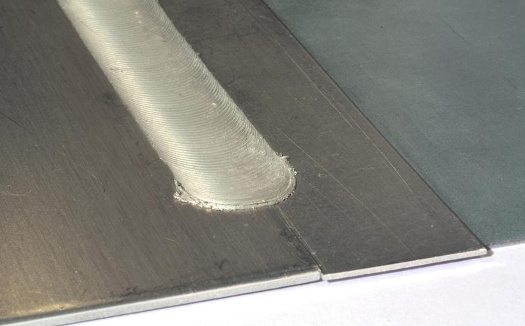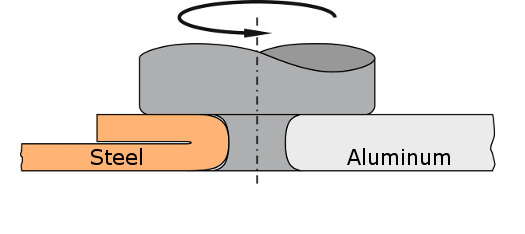 |
| October 25, 2016 | Volume 12 Issue 40 |
Designfax weekly eMagazine
Archives
Partners
Manufacturing Center
Product Spotlight
Modern Applications News
Metalworking Ideas For
Today's Job Shops
Tooling and Production
Strategies for large
metalworking plants
New welding process joins dissimilar sheets better
Friction stir welding is a still-young (and often unfamiliar) pressure-welding process for joining flat components and semi-finished components made of light metals. Due to the great joint strength that can be achieved and the associated lightweight construction potential, this process is being used increasingly in the automobile industry, mechanical engineering, and in aviation and railcar construction.
A friction stir welding machine looks and acts like a cross between a drill press and a sewing machine. Lowered onto two metal sheets sitting side by side, the "drill bit," or in this case pin tool, spins against both edges. As it travels along, the pin creates friction that heats, mixes, and joins the alloys without melting them.

With a newly updated friction stir welding process, it is possible to join steel and aluminum sheets of different thicknesses economically while ensuring high-strength joints.
Scientists at the University of Stuttgart in Germany have now developed two new process variants that aim to expand the areas of application for friction stir welding considerably. Thanks to these procedural variants, it is possible, for the first time, to use friction stir welding to join steel and aluminum sheets of different thicknesses economically while ensuring high-strength joints. This way, material utilization of thin steel sheets in aluminum-steel mixed chassis applications can be increased by up to nearly 100 percent.
Steel and aluminum are being used together increasingly in automotive applications and in the mechanical engineering sector. By using the two materials in tandem, it is possible to combine the advantages of both materials, such as the great stiffness and strength of steel and the low density of aluminum. Due to the different levels of strength of the two materials, they are frequently used in different thicknesses, and so their high-strength joining represents an elementary problem in industrial joining technology.
Previously, joints between materials of different types and thicknesses were made using overlap welding, since this joint type bears great bending moment and tensile strengths. In the process, however, bothersome edges arise. In addition, due to the direct combination of different materials and the gaps resulting from the overlap, there is an increased danger of corrosion.
With the friction stir welding processes developed at the Institute for Materials Testing, Materials Science and Strength of Materials (IMWF) at the University of Stuttgart, it is possible to join steel and aluminum sheets of different thicknesses economically while ensuring high-strength joints.
Prof. Dr. Ing. Stefan Weihe, Martin Werz, Max Hobfeld, and Oliver Volz, the engineers and specialists doing the research at the IMWF and the MPA Stuttgart, developed two new processes where aluminum and steel sheets of different thicknesses can be joined to form a high-strength butt joint. These joints demonstrate great tensile and fatigue strength .
With the first procedure, the steel sheet is locally folded so that its cross-section for joining the aluminum sheet is doubled around the joint zone. This increases the cross-section of the thinner, stiffer sheet at the joint. As a result, the softer aluminum can be joined to the steel across its entire cross-sectional area.

One new process involves folding the thinner steel sheet to create a uniform butt joint with thicker aluminum.
With the second process, thanks to a newly developed tool, it is possible to create a combined overlap and butt joint in just one welding pass. The resulting joining surface is more than doubled as compared to conventional butt joints. This results in excellent static and cyclical joint strength.
For the joining of typical automobile materials (Aluminum EN AW 6016 T4, 2.0 mm and Steel HC340 LA, 1.0 mm), tensile strengths of up to 99.4 percent of the steel sheet is achieved with the new process. The newly developed welding joints therefore spare excess materials and at the same time they increase the safety of vehicle passengers during accidents. Furthermore, the newly developed welding processes increase economy: They require fewer steps and less energy.
In addition to many applications in the automobile industry, the procedure is also interesting for the electrical industry and the electromobility sector, because with friction stir welding, aluminum-copper joints are possible, among other things.
Technologie-Lizenz-Buro (TLB) GmbH supports the University of Stuttgart in patenting and marketing its innovations. Acting on behalf of the University, TLB is in charge of the commercial implementation of these future-oriented technologies on a global level.
For more detailed information, contact Dr.-Ing. Michael Ott (mott@tlb.de).
Source: University of Stuttgart
Published October 2016
Rate this article
View our terms of use and privacy policy
